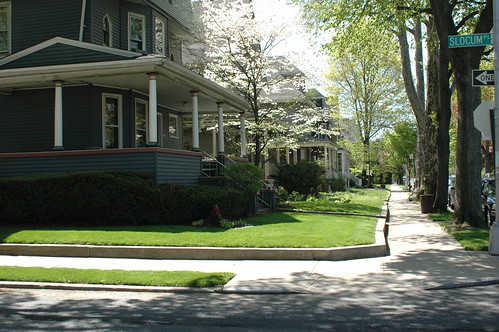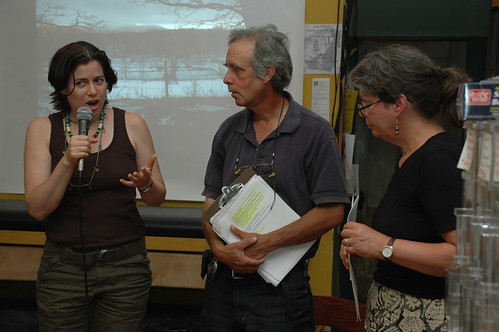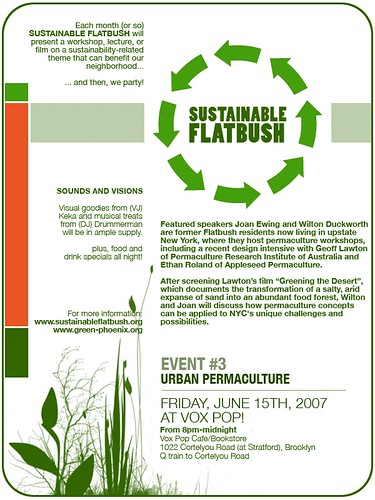Updated 2007.11.30: Added the complete list of ideas which came out of the brainstorming session.
Last night I hosted the kickoff meeting for the Gardening Committee of Sustainable Flatbush. Clockwise from lower left in the photo are Mela, Anne, Lashonda, and Bruni.
At the end of the evening, I asked if someone was willing to co-chair, and Bruni volunteered. She will report to the general meeting next Monday. What follows is my summary of how the evening went.
We opened with some quick introductions, everyone helped themselves to tea and cookies, then we settled in for a quick brainstorming session. As you can see in the photo above, my little card table wasn’t big enough to hold all the ideas we generated in just a few minutes. Next time I’ll use a bigger table.
Next we reviewed everything each of us had written while grouping and clustering the cards. For example, we had clusters for ideas related to composting, schools and youth, gardening techniques, street trees, and community. This sparked more discussion, questions and answers, and more ideas.
The strongest theme to come out of the meeting was “community.” Each of us feels strongly about the connections between community and gardening. I talked about my experiences with the Daffodil planting on Cortelyou Road. Bruni talked about her experiences with a community garden, and the community of gardeners, in the East Village. Others talked about their desires to organize people in their buildings, and on their blocks.
We decided to focus on a single near-term action: a public community meeting in late February. The idea is to get people excited about the possibility of doing something with their building, their block, their neighbors in 2008, and connect them with opportunities to learn more and organize. I’ve contacted BBG’s Brooklyn Greenbridge to see if they can do a Flatbush-oriented version of their “Greening Up Your Street” program. Even if not, we’ll be able to put some kind of program together.
We don’t have a date yet for our next meeting. We’re thinking it might be sometime in January. When we have a date, it’ll be announced here and on the Sustainable Flatbush motherblog.
I’m inspired by this definition of community gardening:
What is a Community Garden?
Any piece of land gardened by a group of people.
– American Community Gardening Association
By this definition, we can create “Community Gardens” everywhere:
- Tree pits
- Median strips
- Planter boxes
- Grounds and foundation planting areas of apartment/coop/condo
buildings
Imagine turning our streets into community gardens …
I’ll close with this photo. This shows the state of our table workspace after we had done the grouping and clustering. Visit the Flickr photo pages for this and the opening photo; they have notes with the text from some of the cards. This photo also shows that my home-made, from scratch, double Callebaut bittersweet chocolate chip cookies were well-received.
The crayons were popular. I also ended up with some nice drawings and doodles on the paper covering the card table. I’ll have to get some photographs of those as well.
Ideas
Here’s the complete list of ideas, in alphabetical order, which came out of our brainstorming session.
Adopt a tree
Apartment building gardens/landscaping
Aromatic gardening
Assisting renters in taking/using green space in or around buildings
BBG/Brooklyn Greenbridge
Benches around tree pits (wood benches)
Brooklyn College Garden
Buddy gardening
Build community
City repair (Portland model)
Community composting
Community garden
Compost
Demonstration gardens
Donate food grown to families with food challenges
Educate neighbors about types of trees in neighborhood
Engage youth/children
Find neighbors with farming experience
Food, not lawns
Gardens/farms in schools
Green roofs
Ground cover for older tree pits
Grow food
Guerilla gardening
Highlight/profile local gardeners
Kids education (PS 139, PS 217, and at other local schools)
Lawn care practices
Library Plaza Garden
Million Trees NYC
Planting in Newkirk Plaza
Public composting
Rain barrels
Rain gardens
Red Hood Community Farm
School compost
Sponsor a tree
Street arboretum
Tree signs
Vermi-composting
Window boxes
Xeri-scaping









